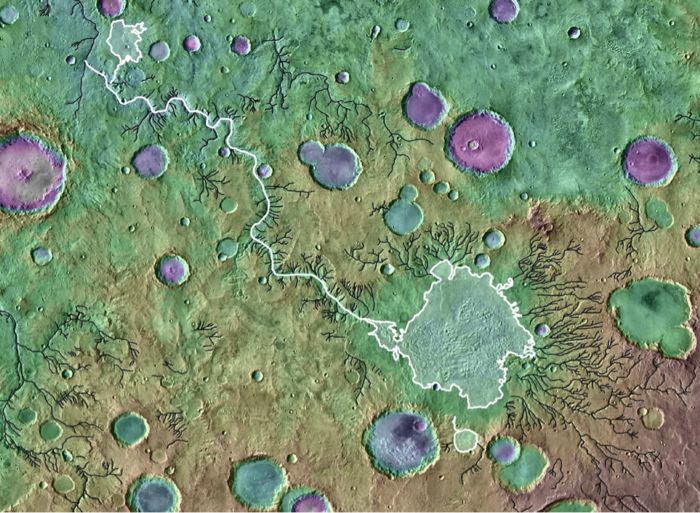Massive floods on Mars
Today, it’s pretty dry on the Red Planet. But that wasn’t always the case – quite the opposite, as researchers at the University of Texas at Austin can see from the way rivers and lakes have changed. On Earth, erosion by rivers is usually a slow process. On Mars, however, massive floods from overflowing crater lakes played a preeminent role in shaping the Martian surface, scouring out deep chasms and moving huge amounts of sediment.
The study, published Sept. 29 in the journal Nature, shows that the floods, which likely lasted only a few weeks, removed more than enough sediment to completely fill Lake Superior and Lake Ontario. “When we think about how sediment moved across the landscape on ancient Mars, flooding from lake incursions was a really important global process,” said lead author Tim Goudge. “And that’s a somewhat surprising result because they were thought to be unique for so long.”
Crater lakes were common on Mars billions of years ago, when the Red Planet had liquid water on its surface. Some craters could hold the amount of water of a small sea. But when the water became too much, it burst beyond the rim of the crater, causing catastrophic floods that washed out entire river valleys. Remote sensing images taken by satellites orbiting Mars have allowed scientists to study the remains of collapsed crater lakes on Mars. However, crater lakes and their river valleys have mostly been studied individually. This is the first study to examine how the 262 broken-up lakes on the Red Planet shaped the Martian surface as a whole.
For the study, an existing catalog of river valleys on Mars was reviewed and the valleys were divided into two categories: Valleys that formed on the rim of a crater, suggesting they formed during a flood from a lake collapse, and valleys that formed elsewhere on the landscape, suggesting they formed gradually over time. The scientists then compared the depth, length, and volume of the different valley types and found that river valleys formed by crater lake collapses punched well above their weight, eroding nearly a quarter of the volume of river valleys on the Red Planet, even though they accounted for only 3% of the total valley length. At 170.5 meters (559 feet), the mean depth of a breakthrough valley is more than twice that of other river valleys that were formed gradually over time and have a mean depth of 77.5 meters (254 feet).
And although the chasms were formed in a geologic instant, they may have had a lasting impact on the surrounding landscape. The study suggests that the collapses eroded canyons so deep that they may have influenced the formation of other river valleys nearby. According to the authors, this is a possible alternative explanation for the unique topography of the river valleys on Mars, which is otherwise attributed to climate.

